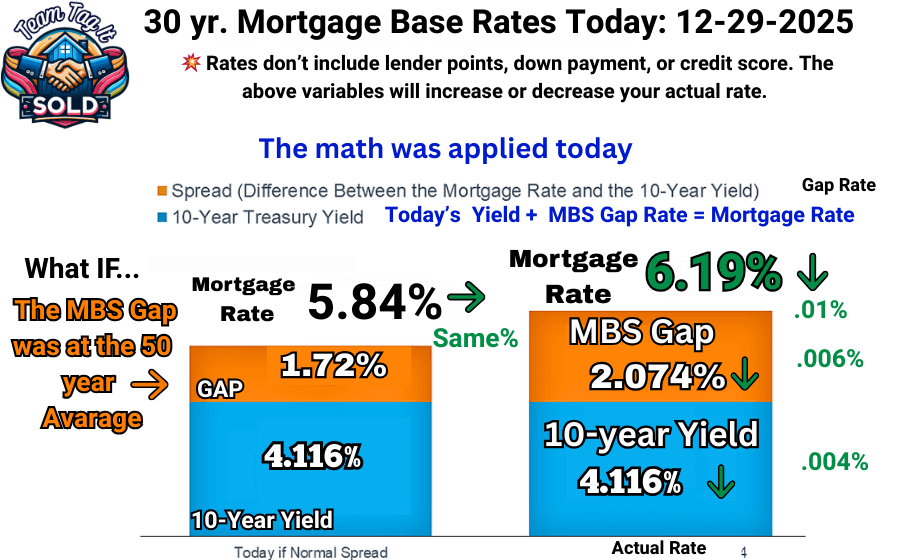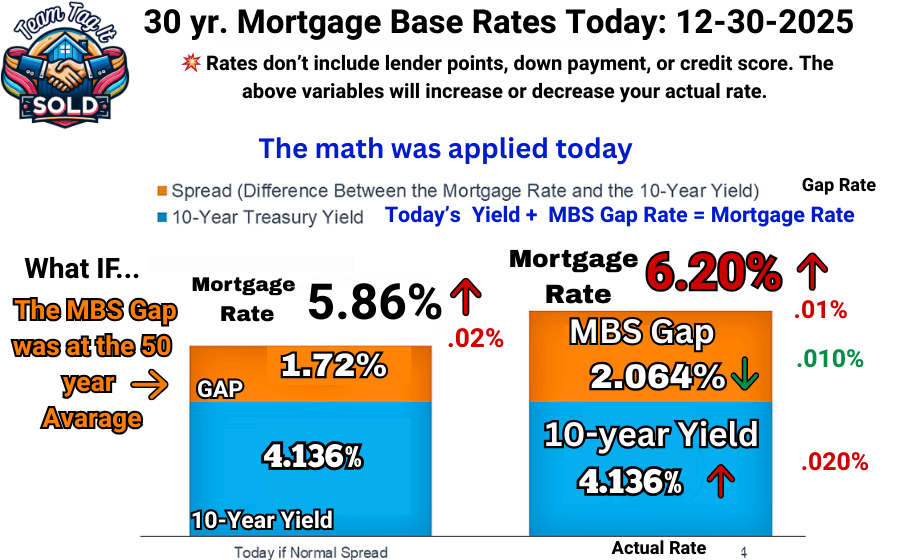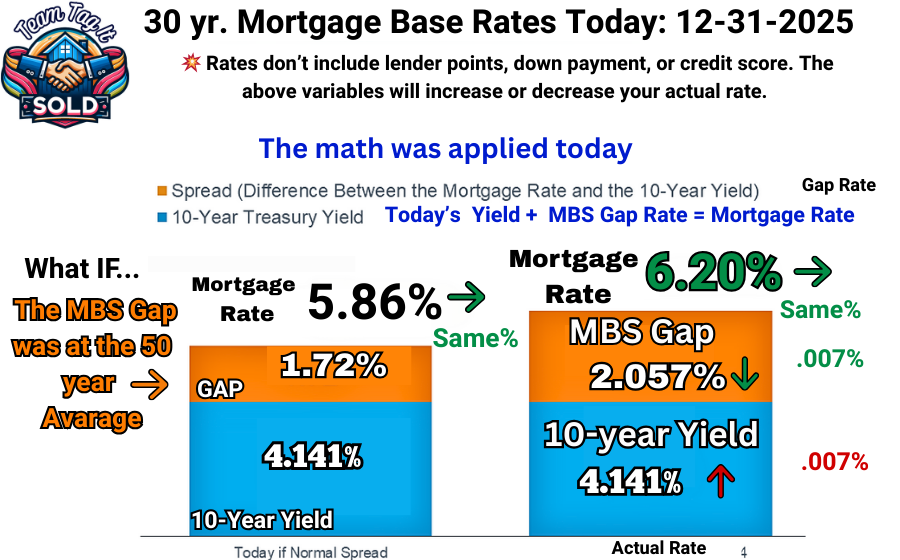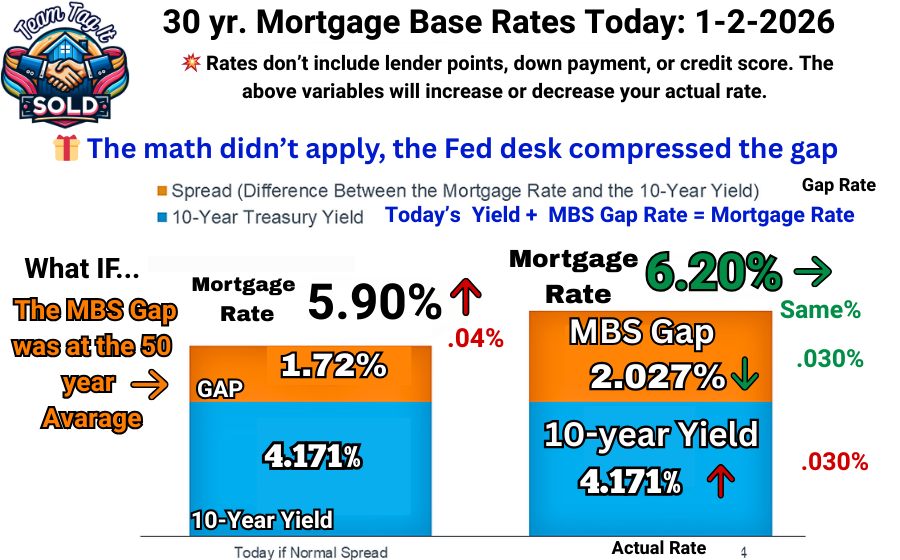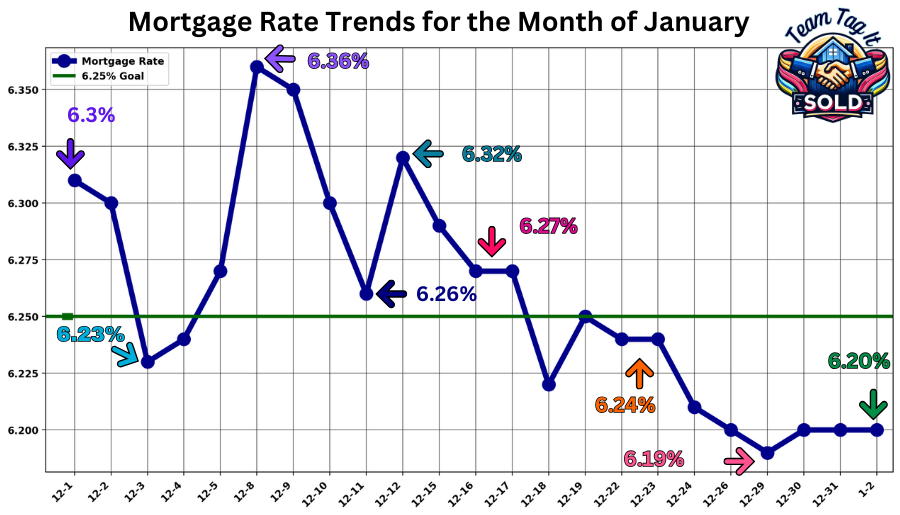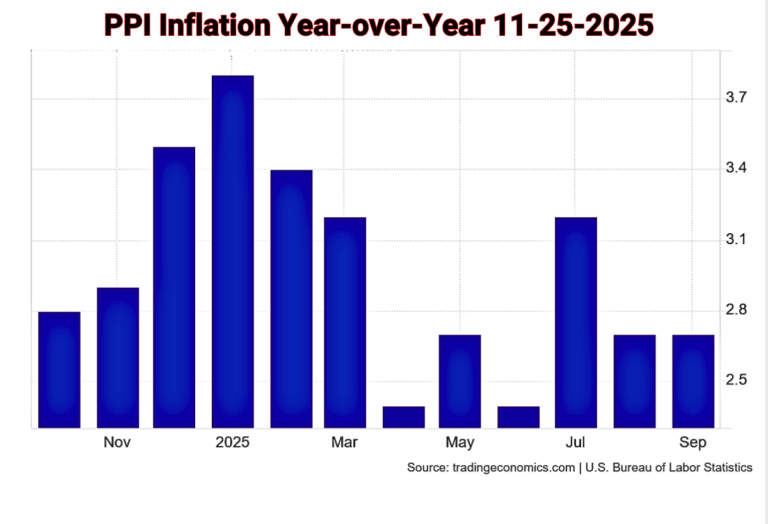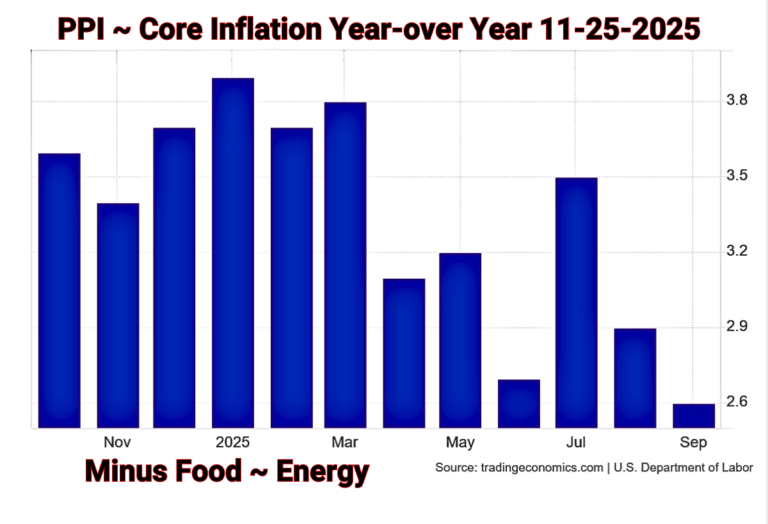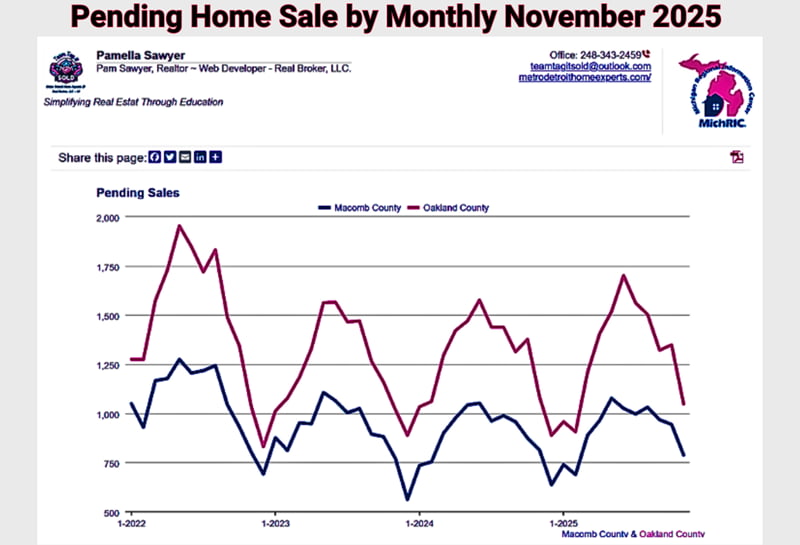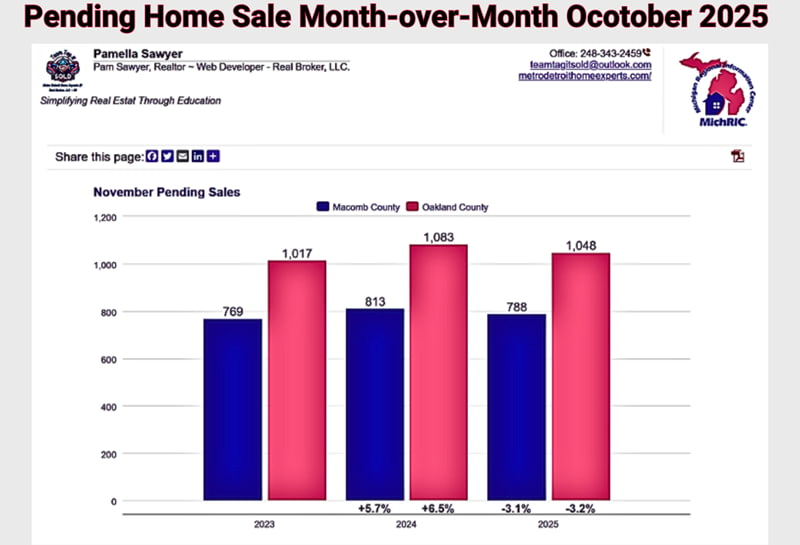Crack the Mortgage Rate Code and Save 💲~
⚠️Rate Caution Ahead
Mortgage rates don’t move on headlines 📰 alone—they move on patterns. This weekly breakdown shows how to identify the signals that trigger a mortgage rate spike ⬆️ or a dip ⬇️, and which news events the market consistently ignores. By tracking bond market behavior, MBS gap shifts, and lender pricing trends, you’ll learn when rates may stabilize and when risk is building ⚠️. Understanding the “WHY” behind rate movement helps buyers and homeowners make decisions with clarity—and avoid costly surprises—right here in Metro Detroit 🏡.

Let’s Crack the Mortgage Rate Code and Save🏡💰 ~ Week Ending January 3, 2026
Hey, Metro Detroit neighbors 👋—this weekly breakdown focuses on the WHY behind mortgage rate changes, not just what they did. Instead of reacting to headlines 📰, I break down the WHY behind mortgage rate shifts by analyzing bond market behavior, MBS gap movement, and lender pricing patterns. Over time, you’ll learn WHY rates spike ⬆️ or dip ⬇️, how to recognize repeatable patterns ⏳, and WHY timing your lock matters—so you aim to lock on a dip, not a spike.
Bookmark this post for your weekly insider breakdown. And don’t forget to check and bookmark 🔖 Today’s Mortgage Rates — for Dip and Spike Alerts 📢 so you can stay in front of the daily shifts. Knowing the trend helps you time it right and make smarter moves on your next home.📉📈
💌 Want exclusive alerts? Get updates straight to your inbox or phone. Subscribe to our newsletter for real-time rate shifts, text alerts, and expert insights! 📩📲 Don’t miss out on your chance to save big!
🔎 Your Why behind Mortgage Rates
Every day, I break down WHY mortgage rates rise or fall daily—so you don’t have to guess! 📉📈 Want to stay ahead? I highly recommend 🔖 bookmarking “Today’s Mortgage Rates” for daily updates on what’s moving the market.

Last week’s why answered~ Why the Math is important
Last week, I told a quiet but powerful story. Mortgage rates spiked as predicted. Last week exposed a deeper problem: the treasury spending is out of control. To take it a step further, the FHFA Fed desk is still compressing the gap. That’s where the trouble begins. When a federal agency overrides market signals, the system stops behaving like a market. And investors notice. They rely on clean, honest numbers — from the Bureau of Labor Statistics (BLS) to the FHFA — to guide their trust in the direction of the economy. When the math is muted or ignored, confidence erodes fast.
⚠️ WHY Caution Is Warranted Going Into Next Week
The 10-year Treasury yield spiked and closed at 4.191 📈, and the WHY behind that move isn’t clear yet. Was it holiday positioning and cleanup, or—more concerning—are investors again setting higher coupon demands at Treasury auctions? Last month, a similar auction-driven move pushed yields up 0.075%, and mortgage rates jumped from 6.27% to 6.36% in just 24 hours.
Here’s why this matters now: mortgage rates are being held near 6.20% not by market math or stronger UMBS prices, but by accelerated MBS gap compression from the FHFA Fed desk. That support can’t last forever. If yields stay elevated, the pressure builds—and a gap correction could push mortgage rates higher quickly. This is precisely why following Today’s Mortgage Rates: What’s Driving the Change is essential—because the next shift may come fast.
💭 How Investors Feel When the Math Is Ignored
- ⚠️ Distrustful: Investors rely on math — yields, spreads, auctions — as their compass. When the FHFA overrides those signals, it feels like the compass is broken.
- 🛡️ Exposed: Without math as the anchor, they assume they’re trading against policy levers rather than fundamentals. It leaves them feeling vulnerable.
- 🕊️ Cautious: With fundamentals sidelined, investors hesitate to commit capital. They hedge, pull back, or shift into safer assets instead of supporting housing finance.
Step #1 ~ 💥 Yield + MBS Gap = Mortgage Rates 💥
💥 This is the most critical piece of the puzzle! 💥 If you want to predict mortgage rate movements, you must understand Mortgage-Backed Securities (MBS). 📊 Once you grasp these trends, you’ll know exactly when to lock your rate and buy your new home confidently, knowing you‘re saving money. 🔑💰
💡 How to Calculate Mortgage Rates
📊 Breaking it down on the Right: 🗓️ Current Mortgage Rates for the week
🔹 The teal graph represents the 10-year Treasury Yield Rate. 📉
🔸 The orange graph shows the MBS Price Gap Rate.📊
➕ Add them together, and you get the mortgage rate—your top number! 💡🏠
Now, let’s talk about the “What-If” on the left scenario. 📉📈 The left-side graph highlights why tracking the MBS Gap Rate is crucial—it directly affects your mortgage rate! Keeping an eye on this gap can help you predict when rates will rise or fall before they do.
Monday: The Market Set the Tone 📉
Monday set the tone for the week as the 10-year Treasury yield dipped 📉, giving the MBS gap a brief compression break. The key WHY: economic reports released this month failed to move Wall Street investors in either direction. With it being a holiday week 🎄, trading volume was lighter, and markets remained calm and range-bound. When data doesn’t sway investors, and liquidity is thin, mortgage rate movement slows—not because risk is gone, but because conviction is absent.
📅Tuesday: Waiting on the Fed 😬
Tuesday brought a Federal Reserve report 🏦, but the market reaction was muted—the key WHY: Wall Street viewed the data as confirmatory rather than directional. The 10-year Treasury yield held steady, and without a yield move, mortgage rates had little reason to reprice. When Fed messaging aligns with existing expectations, markets pause—and stability, not volatility, becomes the outcome. What we saw on Tuesday was a typical market drift.
📅Wednesday: Why mortgage rates stayed stable
Wednesday’s initial jobless claims report came in better than expected, but mortgage rates remained stable. The key WHY: Wall Street discounted the headline due to seasonal distortions common in December, including temporary holiday hiring and the slowdown in construction and farm work. At the same time, other labor data—weaker job openings, softer hiring, and reduced hours worked—contradicted the claims report. With mixed signals and no apparent labor acceleration, yields held steady, and the MBS gap continued to cushion mortgage rates.
📅 Thursday: Markets are closed

📅 Friday: Back to Reality 📊
On Friday, the 10-year Treasury yield began climbing before markets even opened 📈. By 10:00 a.m., the yield was already up 0.030% and still rising. Under normal conditions, that kind of move would have pushed mortgage rates higher. Instead, when rates were released, the MBS gap absorbed the entire yield spike, compressing to the lowest level we’ve seen since the pandemic.
🚨 Here’s where caution comes in.
The Federal Housing Finance Agency (FHFA) Fed desk, acting as conservator for the Government-Sponsored Enterprises (Freddie Mac and Fannie Mae), continues to hold mortgage rates down through aggressive MBS gap compression—even as UMBS 5.0 prices closed at just 99.67. That’s not market-driven math; it’s policy support. The question is how long that support can hold.
Looking ahead, we have a 10-year Treasury bond auction on January 12. Three days before the auction, we’ll learn the deficit amount the Treasury needs to borrow to pay the bills. At the same time, the Federal Reserve is expected to increase short-term bond purchases, which can further weaken demand for long-term bonds. If investors demand higher coupons to absorb that supply, yields rise—and if the Fed desk steps back and applies the math, mortgage rates could climb back toward 6.4% or higher.
⚠️ This is why the following move matters—and why daily monitoring is essential right now. Follow Today’s Mortgage Rate: What’s driving the change!
Mortgage Rates: December Month End
This graph shows the rise and fall of mortgage rates over the past several weeks, making it easy to see how quickly the market can shift as the bond market reacts to policy, economic data, and interest rate cuts. 📈📉 In November, the Federal Reserve didn’t meet, so mortgage rates stayed in the 6.3% range, and the math was applied. We started to see mortgage rates shift lower and gap compression after the noise around an interest rate cut in December increased. 🔧💸Mortgage rates are low, not because the economy is better or policy, but because the Fed Desk is compressing the gap, forcing mortgage rates lower.
MBS Gap: Rolling 3-Month Trend
This view highlights how the MBS Gap compresses like a hero 🦸 or widens like a villain 🦹, often driving mortgage rates more than the yield itself. The FHFA Fed desk compressed the gap to keep mortgage rates lower. Starting on 12-1-2025, we began to see the aggressive gap compressions. This is not math, and it could backfire any day. 💥
📈 What Happened After the Last Four Interest Rate Cuts?
2024 Interest Rate Cuts
September 18, 2024: The Fed dropped rates by 50 basis points. 🔁 Mortgage rates on September 17, 2024, were 6.11% and on September 18, 2024, rose to 6.17%. Over the next several weeks, the yield and MBS gap climbed.
December 18, 2024: Another cut followed, but again, yields rose—not because of inflation, but because investors feared 😨 government debt expansion and weak Fed forward guidance. Rates on December 17, 2024, were 6.92%, and on December 19, 2024, rates spiked to 7.14%.
2025 Interest Rate Cuts
🔶 September 25, 2025
Interest rates were cut by .025% and Wall Street investors hit panic mode, and I’m not sure why. The yield jumped from 4.024% to 4.126%, an increase of 0.102%. But that’s not the only thing that happened that day to send rates soaring. The Fed desk GLS (think Freddie Mac and Fannie Mae) decreased the rate it would pay investors to buy securities from 5.5% to 5%. That caused MBS prices to plummet, and the gap widened by 0.148%. Mortgage rates on September 17, 2025, were 6.15%, and on the 18th, they jumped to 6.37%. Mortgage Rates have remained between 6.35% and 6.39% through September 26.
🔷 October 29, 2025:
Same scenario, different month. This time, the FHFA Fed Desk handled the MBS gap compression differently. They slowly compressed the gap, keeping mortgage rates under 6.25% for several days. Then, on October 28, another significant gap compression brought mortgage rates to 6.13%. But his time, the whiplash wasn’t as severe the day after, and mortgage rates climbed to 6.27%. But that didn’t last; by day 5, mortgage rates were back up to 6.37%.
♦️December 10, 2025.
A different playbook. The December 10 interest rate cut followed a very different playbook than earlier cuts this year. In September and October, aggressive gap compression pushed mortgage rates down to 6.13%, even though the math didn’t fully support it. This time, the FHFA applied restraint, compressing the gap without over-suppressing it. As a result, mortgage rates only dipped briefly into the 6.25% range for about two days before moving back higher. The market corrected quickly, confirming that the natural range for mortgage rates is in the 6.3s, not below 6.25%. This wasn’t a failed rally — it was a controlled response that reinforced where rates realistically belong right now.
So yes, lenders remember this pattern: Rate cut → market disappointment → yield spike → margin squeeze. When the yield spike occurs, Wall Street refuses to take the bait, and chaos ensues. 👿
🔎 Economic Reports that affect the bond Yield and your mortgage Rate 📈📉
The economic reports below provide context, not direction. Data from the Bureau of Labor Statistics (BLS) and the Department of Labor (DOL) can trigger initial bond market reactions, shaping the 10-year Treasury yield, the MBS gap, and mortgage rates 📊. Reviewing these reports helps explain what the market saw before we break down why it responded—or didn’t—this week.
Why the Bond Market Is Ignoring the Noise
Bond markets have largely stopped reacting to headlines, and the WHY is simple. While labor data may look strong on the surface, deeper analysis and cross-checks with Federal Reserve regional bank reports often reveal inconsistencies. Because of that, Wall Street no longer takes economic reports at face value, which explains why yields have remained calm and post-report volatility has faded.
CLICK PICTURE TO ACCESS DATA
The Data That Can Shift Mortgage Rates Overnight
Right now, reports from the Bureau of Labor Statistics and the Department of Labor are no longer moving the bond market needle. Outside the unemployment report—which can still influence future interest rate-cut expectations—Wall Street is essentially looking past the headlines. What’s actually driving mortgage rate risk is Treasury bond auctions, where investors demand higher coupon rates to absorb rising debt. Remember: the 10-year Treasury yield 📈 is the base for mortgage rates. While MBS gap compression can temporarily mask yield pressure, it can’t erase it. When auction risk meets fading policy support, mortgage rates can shift quickly—often overnight.
Initial Jobless Claims: Looking at the graph, it appears to be good news. When you review the microdata and Federal Reserve data, it seems the DOL overcompensated for seasonal claims, giving the impression that fewer layoffs occurred. Now, look at the 4-week average, see the difference?
🗓️ Up and coming
There isn’t much in the reports that could trigger mortgage rates, other than Wall Street investors positioning themselves on what they would be willing to accept to purchase government debt at the auction on January 12th.
January 9th: The Unemployment rate and hourly wages are released. This could be a clue as to what the Fed will do regarding mortgage rates.
🏡 Let’s Decode the Mortgage Market Together! 💰🔎
Let’s Connect ⤵️
Wow! 🤯 There’s a lot to take in, but don’t worry—I’ve got you! Mastering this step is key before searching for your dream home. 🔑Understanding how mortgage rates are determined and how to negotiate with lenders on rates and fees can save you thousands over time. 💵 But it doesn’t have to be complicated! Let’s simplify the process together.📅 Schedule a Zoom call with me, and we’ll review the data step by step. I’ll share my screen to give you a clear view of market insights so you can make confident, informed decisions about your next steps. ✅✨Got questions❓ or prefer a quick chat
💬Call or Text 📞 248-343-2459. I’m here to help anytime! 🆘 Stay current and ahead of your future competition by visiting the website for updated articles 3 to 4 times a week. Mortgage Rates are updated daily.
What My Crystal Ball 🔮 is Telling Me about Future Mortgage Rates in Metro Detroit
⚠️ Disclaimer: This section reflects opinion and market interpretation, not a guarantee or rate prediction. Mortgage rates can change quickly in response to market conditions.
My crystal ball is frustrated. Tariffs are distorting inflation, and the bond market is struggling to maintain stability. 🆘To get ahead, what’s coming, I’m expanding my watch list so we can bring the future back into focus. When I was preparing this report and digging, I was having an anxiety attack about what 2026 could look like, but there is some good news, too. First, mortgage rates could rise due to the chaos at the Federal Reserve and Treasury, which is your bad news. The good news is that your 401 (k), Dow, and S&P (could see gains as high as 14%) could outperform. Why? Because investors have more trust in corporations and now have access to cheaper money. With BLS lagging and weaker bond sales, Fed policies could push yields higher, and we know mortgage rates follow.
🚦 Stop, Slide, or Spike? Rates on the Edge
Here’s my concern going into next week. The 10-year Treasury yield 📈 has already spiked, while the Federal Housing Finance Agency (FHFA) Fed desk has compressed the MBS gap into dangerously tight territory. That combination raises risk. If the MBS gap snaps back, mortgage rates can move higher—fast.
Last Friday’s spike raised a red flag 🚩. Either we saw a bond sell-off, or Wall Street delivered a warning shot to the Treasury—showing what investors are willing to accept in bond coupons. If investors demand to be paid for risk, the real question becomes whether we see another +0.075% jump, which would push the 10-year yield toward the 4.25% range.
What makes this moment difficult is that we can’t rely on surface-level math or headlines 📰. When you dig into the microdata 🔍, the story changes—and markets are responding to that shift. My guidance is simple: brace for volatility ⚠️. If you have a home under contract, locking sooner rather than later 🔒 may reduce risk in a market sitting right on the edge.
💬 Call or Text 📞 248-343-2459 with any questions — I’m here to help anytime. 🆘 Visit the website to stay current and ahead of your future competition.📰 Articles updated 3–4 times a week. 📊 Mortgage rates updated daily.
More Help Is 1️⃣ Click Away⤵️
Pick Your Topic by Scrolling
Today’s Mortgage Rates: What’s Driving the Change 📢 with Video
Crack the Mortgage Rate Code: Know the WHY and Save💲
Metro Detroit Housing Market Trends by City ~ December 2025
Metro Detroit Michigan Homes for Sale Search by City- LIVE MLS
Metro Detroit Sold Home Prices Search by City: Live Data
Adjustable Rate Mortgage (ARM): Smart Move or Mistake❓
Metro Detroit Home Prices and Real Estate Trends by City 🏘️💲
Home Value vs Price in Metro Detroit: Myth Busting Revealed 🤫
Mortgage-backed Securities Effects on Mortgage Rates💲📉
Negotiation Strategies for Home Buyers and Sellers 🙌🏡
Your Home Equity Gains: Game Changer When You Sell🏠📈
Mortgage Pre-Approval: The Secret Power Buyers Need to Know 🎓💲
Buying a Fixer-Upper: Hidden Benefits Most Buyers Overlook 👀
Is it Still a Sellers Market Today in Metro Detroit🏡❓
Will Foreclosures Crash the Housing Market in Metro Detroit Winter 2025
Home Pricing Missteps: What Every Metro Detroit Seller Should Know
How to Choose the Right Buyers Agent: A Must for Home Buyers’ 🛒
Real Estate Guides for Buying and Selling a Home ~ With Video
What Is A True Real Estate Expert: How to Find One🏡💥
Selling Your House As-Is OR Make Repairs Pros🌟 and Cons🚫
Top 3 Home Selling Questions in Metro Detroit Answered 🏡❓
Top Real Estate Agent Skills for Selling Your Home🏡💲
Thinking of Selling Your House: How Long Will It Take?
Is Now a Good Time to Sell Your House❓Let’s Find Out 🥳
Downsizing Your Home Can Help You Fuel Your Retirement🤩🏡💲
Master Your Mortgage Rate: Control the Controllable💰🏡
Inspection vs. Appraisal: Understaning the Key Difference🕵️🏡💲
Discover How Home Equity Can Fund Your Next Move💰
Should You Rent or Sell Your House❓🏡
How to Market Your House for More Money💲🏡🎥
☎ ~ +1 (248) 343-2459
Contact Us
Website Development, Production, and Content by Pam Sawyer @ Team Tag It Sold © 2017 to the current year. All Rights Reserved
The information contained, and the opinions expressed in this article are not intended to be construed as investment advice. Metro Detroit Home Experts ~ Team Tag it Sold does not guarantee or warrant the accuracy or completeness of the information or opinions contained herein. Nothing herein should be construed as investment advice. You should always conduct your own research and due diligence and obtain professional advice before making any investment decision. Metro Detroit Home Experts ~ Team Tag It Sold will not be liable for any loss or damage caused by your reliance on the information or opinions contained herein.

